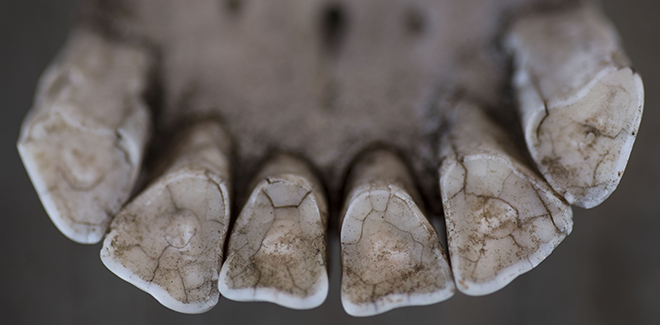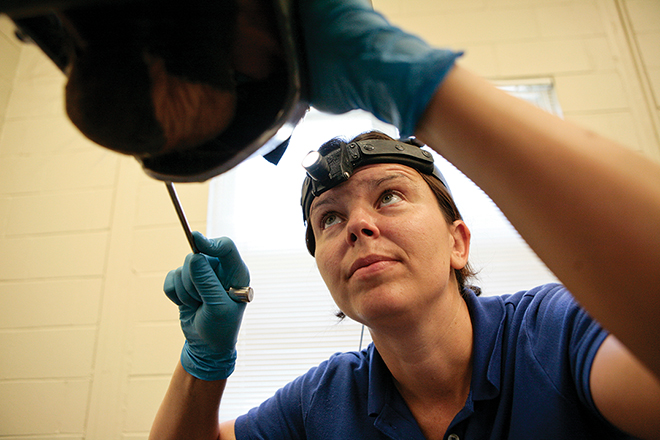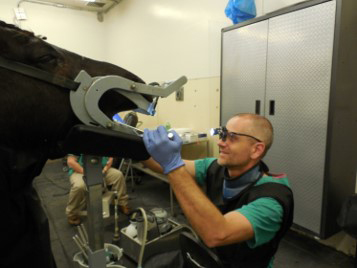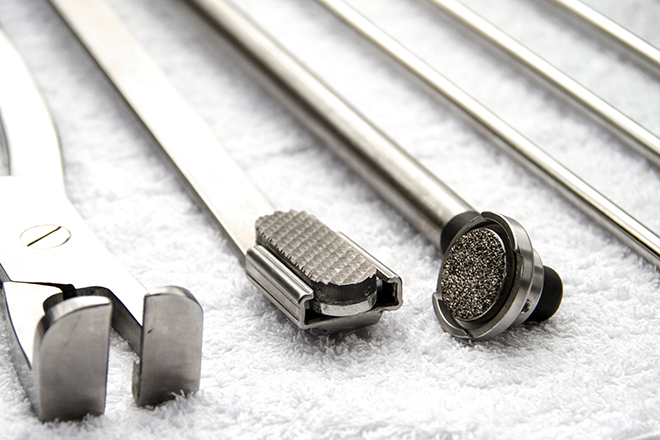
Horses in Ryan Cottingham’s Indiana training barn follow the same dental routine as most people – the horses receive an oral exam twice a year. That allows Cottingham and the equine dentist to enable horses to be comfortable so they can perform their best without the distraction of a problem in their mouth. The preventative approach also helps the team catch any problems early.
“Usually, we schedule visits around the times when we are home for a long period of time. The equine dentist spends three days here getting through all our horses,” Cottingham said. “That usually happens in late November/early December or later in the spring or summer.”
Poor dental health can interfere with the horse’s overall wellbeing. It helps prevent health issues, including but not limited to colic and esophageal choke. More than 60% of horses that have an oral exam are found to have more than sharp enamel points or an imbalance in tooth wear, according to Nicola Pusterla, DVM, PhD, DACVIM and DAVDC-Equine at the University of California Davis Veterinary Medicine. It’s not uncommon to find tooth- or periodontal -related issues.
“Horses are very stoic animals. With many dental pathologies horses show no to minimal signs of discomfort and are retain good body condition,” he said.
A detailed oral exam can include an oral endoscopy and stall side radiographs to provide detailed images of a horse’s tooth or sinuses. Most visits though do not get that involved. Florida trainer Cole Baker schedules twice a year appointments for all young horses and once a year for older horses unless an issue arises that requires additional attention.
“We do all of our colts before we start them to make sure wolf teeth are taken out and the bit seats are nice and smooth,” he said. “We stick with regular visits because it helps prevent bad habits from forming when horses react to sharp points that can happen. Also, dental care ensures they are chewing correctly and getting the most out of their feeds.”
Oral examinations are typically scheduled on an annual basis and become a component of a larger wellness check-up. But some horses need more frequent visits to avoid problems.
Here’s a look at why equine dental is important.
What’s in an oral exam for a horse
An oral examination for your horse is not much different than your visit to the dentist. Prevention is the goal. Ideally, any dental problems in your horse’s mouth are before becoming problematic and require treatment.
“Traditionally, dentistry was just floating teeth or removing sharp enamel points,” said Amelie McAndrews, of Garden State Equine Veterinary Dentistry. She is one of only a handful of veterinarians completing an equine dental residency training program. She is also a clinical associate at the University of Pennsylvania New Bolton Center. “A thorough exam before any treatment is part of good dentistry today.”
The process for an oral exam varies among practitioners. In McAndrews’ opinion the first step in an oral exam she conducts is a basic physical. This includes listening to the horse’s heart, checking his body condition, and understanding if the horse is having any problems maintaining weight. Sometimes, she observes a horse eating or chewing to see if there are any problems. Then she sedates the horse for a good look inside the mouth.
“If you don’t sedate it is impossible to get a complete look,” she said. “Imagine if you’re shaking your head in the dentist’s chair, your dentist would be unhappy with you and couldn’t get a good look in your mouth. The same is true in horses.”
Sedation allows the practitioner to use a speculum to clearly examine soft tissue looking for signs of abnormal masses, abrasions, or cuts on cheeks from sharp enamel points or scars or something that could be a tumor. McAndrews also looks for signs of periodontal disease and signs of fractures, cavities or infections.
“I understand that some people have a concern about extra sedation,” she said. “Sedatives are very safe and tested extensively. Older horses that have heart conditions get are little extra care but specialists I work with once a week at the University of Pennsylvania New Bolton Center assured me they are safe.”
Equine dentists aren’t licensed to sedate horses and have procedures to complete their work without it or arrange to have a vet meet them at the appointment. Cottingham uses an equine dentist, and sedation is usually not part of the procedure. During normal visits, a light hand float is done on each horse.
“I see him as an expert because this is what he does all day every day,” Cottingham said. “He works on a lot of Thoroughbreds and Standardbreds at the track so I appreciate the amount of handling he does.”
Possible dental problems
Unlike most other mammals, a horse’s cheek teeth never stop erupting. Horse teeth continue to erupt between three to five millimeters each year. Teeth balanced between top and bottom but occasionally some become dominant and cause greater wear on opposing teeth one gets longer than opposite tooth.
Misalignments in the mouth are broadly called malocclusions and are divided into classifications by severity. A malocclusion can include a wave, an unnatural undulation across the chewing surface. A misalignment may lead to a variety of problems, one of which is the development of sharp buccal and lingual points. Buccal refers to the cheek side of the tooth and lingual is the tongue side.
Another imbalance is called a step, which occurs when one cheek tooth is longer than the others. This often happens when the opposite tooth fractures or is missing. As the horse chews wear becomes uneven.
“When cheek teeth contact each other on a horizontal plane it is easy for a horse to chew, however, when one or multiple cheek teeth display malocclusion, it becomes harder for that horse to process hay,” Pusterla said.
Baker has noticed that horses with uneven wear can become less soft in the mouth or are “touchy.” Even mild distraction from discomfort in the mouth can interrupt a horse’s focus in training or showing.
“Our dentist checks for wolf teeth, caps and sharp points and makes sure the motion and way their teeth touch each other is correct,” he said.
Research about equine oral health is limited. That has led to the regular removal of wolf teeth when the horse is young. For colts that is when they are castrated. For other young horses, it’s during a regular exam. It’s a simple procedure and the tooth pops out thanks to the shallow roots but may not be always 100% necessary.
“In general, removing wolf teeth is a relatively minor procedure but there is not a ton of research out there,” McAndrews said. “It is always worth a discussion. Sometimes there is a blind wolf tooth that didn’t quite erupt all way through gingiva, which gets pinched.”
Signs of a problem
A change in daily eating habits, including weight loss, eating hay before grain, dunking hay in water, or larger than normal feed particles in the manure may indicate a dental problem.
“Sometimes the nutritional effect teeth can have is overlooked,” Cottingham said. “The mind goes to switching what a horse is being fed like obtaining a better feed or higher quality hay. But if they are unable to utilize what you’re feeding them because of their teeth it doesn’t really matter what they eat.”
McAndrews visited a broodmare struggling to maintain her weight and experiencing colic episodes. She found abnormal tissues and possibly a sinus tumor.
“The mare had recently had incisors and front teeth extracted but the tissues didn’t heal two months later,” she said. “I did an oral exam and took radiographs for the ulcerated areas where the incisors used to be and suspect she has a sinus tumor so took tissue samples too.”
Changes in behavior are another indication your horse may be experiencing dental discomfort. Head tossing, tilting of the head, difficulty bridling, grabbing the bit/lack of control and rearing, either in hand or under saddle. McAndrews recalls another recent case where a mild-mannered, solid citizen let out a huge buck when the rider applied rein pressure. It surprised the trainer and riders alike.
“Turns out he had an incisor that was loose, signs of a disease called EOTRH,” she said. “It’s a disease where the incisors get weak and fracture but we don’t know what causes the disease.”
EOTRH typically shows up in older horses and destroys the incisors and canine teeth, and sometimes cheek teeth. As the disease progresses, the roots of multiple teeth begin to resorb (dissolve), and the swellings around the roots of affected teeth occur.
“It would be nice to more about how to prevent this condition and the risk factors associated with it,” Pusterla added. “For now, the remedy for this inflammatory condition is to pull the tooth or teeth.”
Tooth problems can show up at any age. Cottingham currently has a horse 7-year-old horse in his program that has been in his program since his 3-year-old year and receiving regular dental care. It wasn’t until this year that the dentist discovered a molar growing in crooked. The tooth was pulled and now they are watching the same tooth on the opposite side of the mouth.
“We noticed small behavior problems. He’s been in our program for several years but we didn’t assume his mouth was okay,” he said.
Monitoring horses for dental problems is important to keeping them healthy. Other signals to watch for include:
• Change in the smell of your horse’s breath.
• Discharge from its mouth and nostrils.
• Quidding or balling of hay.
• Change in gum color.
• Sores on the lips, gums, palate, or soft tissue.
Planning a dental exam
There are currently as many different laws and regulations regarding equine dental care as there are states in the country. Each state is different and has its own laws and regulation on who can provide dental care to the horse and under what level of veterinary supervision. Only veterinarians can provide sedation in any state.
“In some states lay floaters are licensed so it is good to know the regulations where you live,” McAndrews said. “Only vets can sedate a horse because they have training far beyond dentistry and understand the whole horse.”
Whether you choose a veterinarian or an equine dentist for your horses largely depends on the state you live in. Pusterla and McAndrews agree it’s important for both professions to work together for the wellbeing of the horse.
Regardless of who you choose to perform your horse’s dental care, Pusterla recommends starting as soon as possible. As soon as a foal is born it should have an exam to check for a parrot mouth or cleft pallet and decide on treatment as necessary.






You must be logged in to post a comment Login